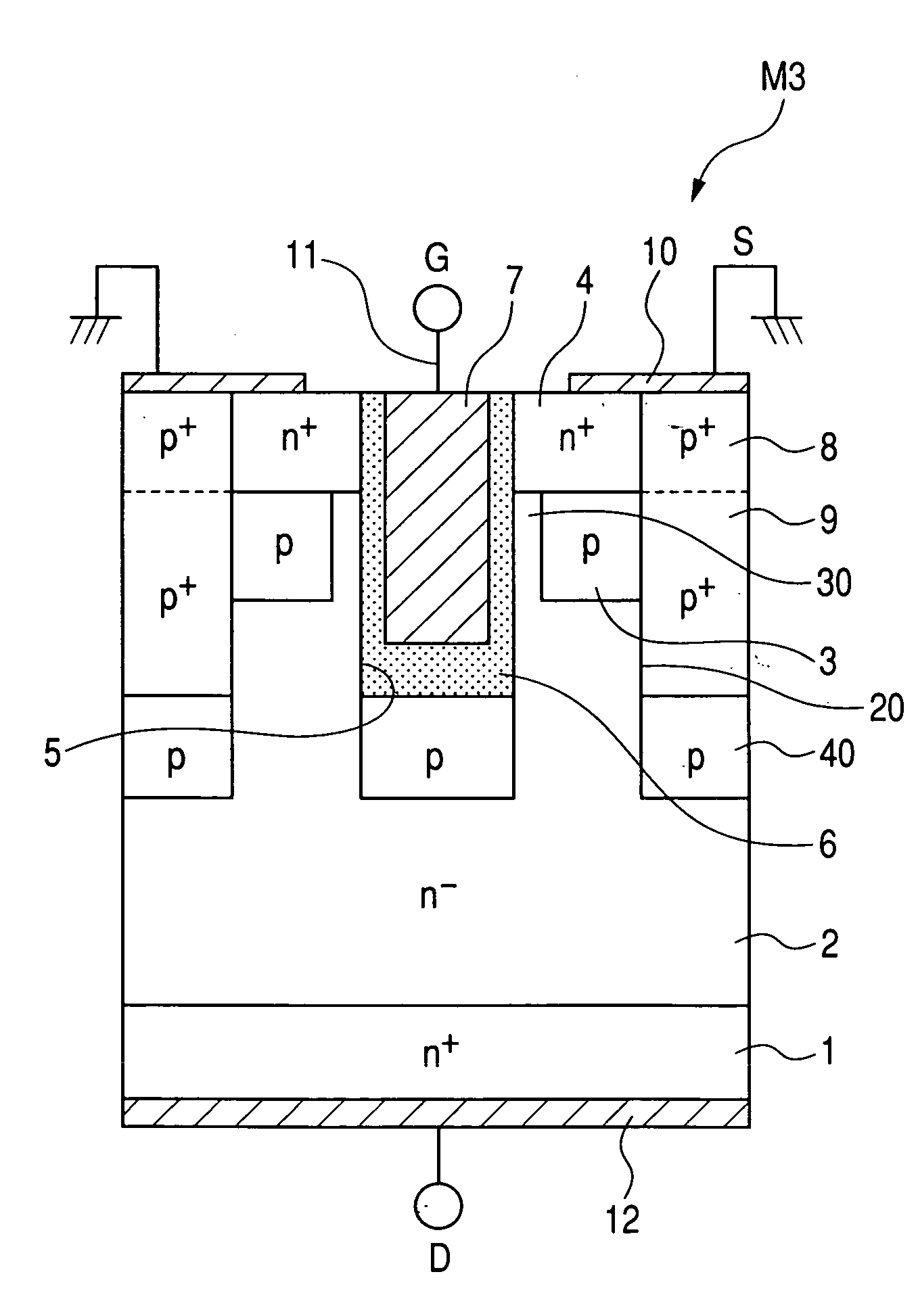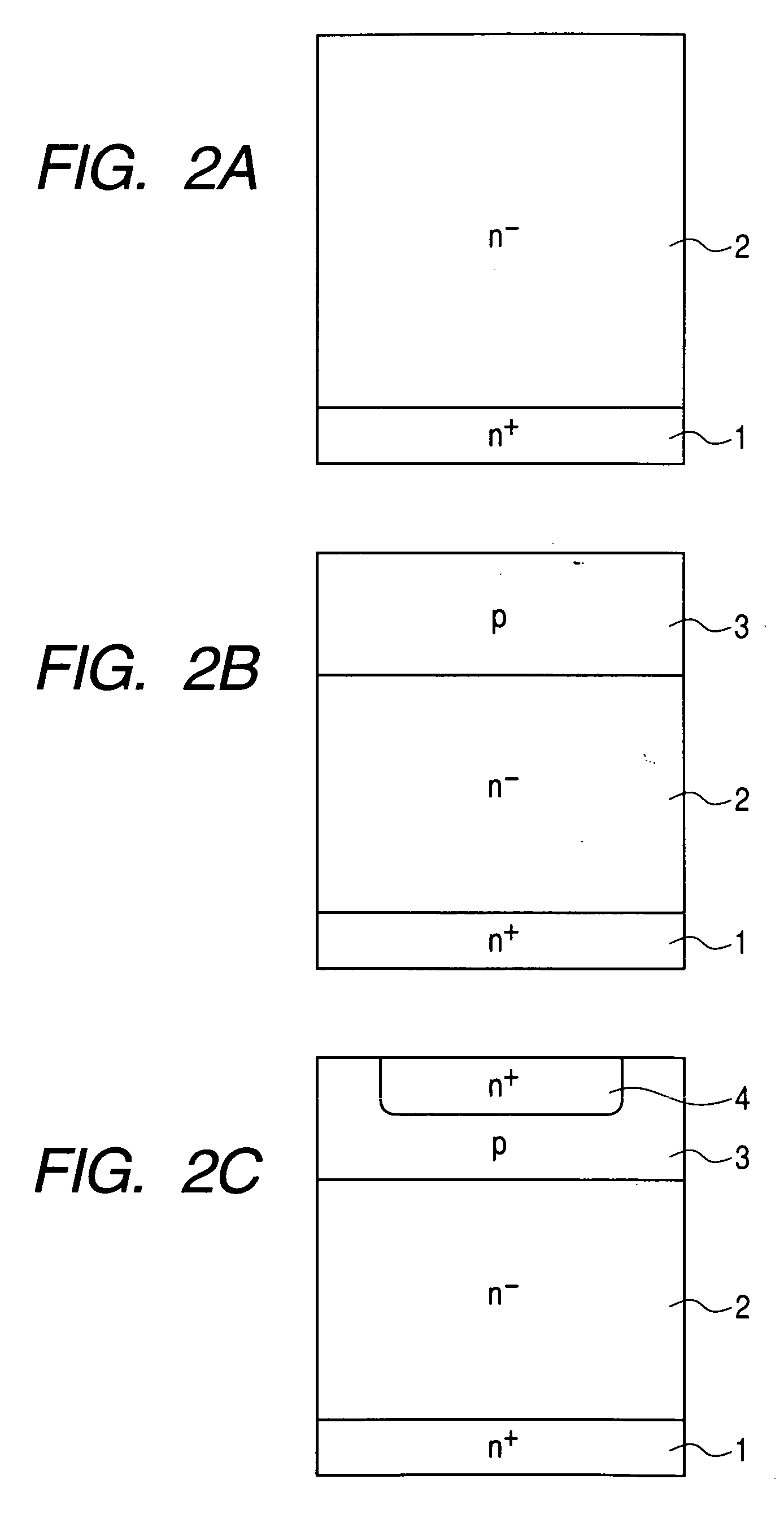Silicon carbide semiconductor device and related manufacturing method
a technology of silicon carbide and semiconductor devices, applied in semiconductor devices, electrical apparatus, transistors, etc., can solve problems such as difficulty in high voltage, and achieve the effects of improving effect, low resistance, and reducing the electric field of an area beneath the trench
- Summary
- Abstract
- Description
- Claims
- Application Information
AI Technical Summary
Benefits of technology
Problems solved by technology
Method used
Image
Examples
first embodiment
[0039]A silicon carbide (SiC) semiconductor device of a first embodiment according to the present invention will be described below in detail with reference to FIGS. 1 to 3. Here, a MOSFET of an inversion-type trench gate structure will be described as an element incorporated in the SiC semiconductor device.
[0040]FIG. 1 is a cross-sectional view of the MOSFET of such a trench gate structure of the present embodiment. Although FIG. 1 shows the MOSFET in terms of only one cell, it will be appreciated that the semiconductor device takes the form of a structure including a plurality of MOSFETs juxtaposed to each other with the same structures as that of the MOSFET shown in FIG. 1.
[0041]As shown in FIG. 1, the MOSFET M1 employs an n+-type substrate 1 as a semiconductor substrate, which has a surface laying on a (000-1) c-plane with a thickness of about 300 μm while containing a nitrogen (an n-type impurity) concentration of approximately 1.0×1019 / cm3. The n+-type substrate 1 has one surf...
second embodiment
[0067]A MOSFET M2 of an accumulation-type trench gate structure of a second embodiment according to the present invention will be described below with reference to FIG. 4. The MOSFET M2 of the present embodiment has the same fundamental structure as that of the MOSFET M1 of the first embodiment set forth above. Thus, the MOSFET of the present embodiment will be described below with a focus on points different from the MOSFET M1 of the first embodiment.
[0068]FIG. 4 is a cross-sectional view of the MOSFET M2 of the accumulation-type trench gate structure of the present embodiment. As will be clear from FIG. 4, the p-type base regions 3 are spaced from the sidewalls of the trench 5 each by a given distance to provide a structure with the n−-type drift layer 2 remaining in an n-type channel layer 30.
[0069]The MOSFET M2 of such an accumulation-type trench gate structure of the present embodiment will operate in a manner described below.
[0070]Under a condition before a gate voltage is app...
third embodiment
[0081]A MOSFET M3 of an accumulation-type trench gate structure of a third embodiment according to the present invention will be described below with reference to FIG. 7. The MOSFET M3 of the present embodiment differs from the MOSFET M2 of the trench gate structure of the second embodiment in respect of reserve layers being additionally provided. The MOSFET M3 of the present embodiment has the same fundamental structure as that of the MOSFET M2 of the second embodiment and, hence, description will be made with a focus on such a differing point.
[0082]FIG. 7 is a cross-sectional view of the MOSFET M3 of the accumulation-type trench gate structure of the present embodiment. As will be clear from FIG. 7, the MOSFET M3 of the present embodiment has areas, placed beneath the p+-type deep layers 9 at positions below the bottom wall of the trench layer 5, which have p-type reserve regions 40. Each of the p-type reserve regions 40 has a lower concentration than that of the p+-type deep laye...
PUM
 Login to View More
Login to View More Abstract
Description
Claims
Application Information
 Login to View More
Login to View More - R&D
- Intellectual Property
- Life Sciences
- Materials
- Tech Scout
- Unparalleled Data Quality
- Higher Quality Content
- 60% Fewer Hallucinations
Browse by: Latest US Patents, China's latest patents, Technical Efficacy Thesaurus, Application Domain, Technology Topic, Popular Technical Reports.
© 2025 PatSnap. All rights reserved.Legal|Privacy policy|Modern Slavery Act Transparency Statement|Sitemap|About US| Contact US: help@patsnap.com



